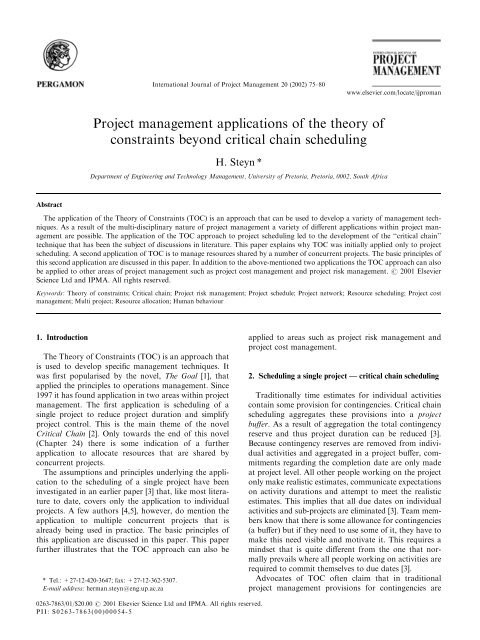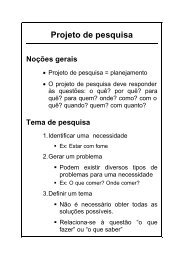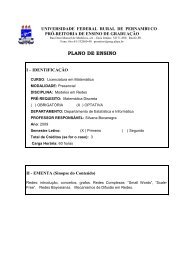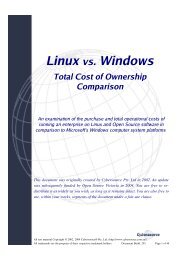Project management applications of the theory of constraints beyond ...
Project management applications of the theory of constraints beyond ...
Project management applications of the theory of constraints beyond ...
Create successful ePaper yourself
Turn your PDF publications into a flip-book with our unique Google optimized e-Paper software.
International Journal <strong>of</strong> <strong>Project</strong> Management 20 2002) 75±80www.elsevier.com/locate/ijproman<strong>Project</strong> <strong>management</strong> <strong>applications</strong> <strong>of</strong> <strong>the</strong> <strong>the</strong>ory <strong>of</strong><strong>constraints</strong> <strong>beyond</strong> critical chain schedulingH. Steyn *Department <strong>of</strong> Engineering and Technology Management, University <strong>of</strong> Pretoria, Pretoria, 0002, South AfricaAbstractThe application <strong>of</strong> <strong>the</strong> Theory <strong>of</strong> Constraints TOC) is an approach that can be used to develop a variety <strong>of</strong> <strong>management</strong> techniques.As a result <strong>of</strong> <strong>the</strong> multi-disciplinary nature <strong>of</strong> project <strong>management</strong> a variety <strong>of</strong> di€erent <strong>applications</strong> within project <strong>management</strong>are possible. The application <strong>of</strong> <strong>the</strong> TOC approach to project scheduling led to <strong>the</strong> development <strong>of</strong> <strong>the</strong> ``critical chain''technique that has been <strong>the</strong> subject <strong>of</strong> discussions in literature. This paper explains why TOC was initially applied only to projectscheduling. A second application <strong>of</strong> TOC is to manage resources shared by a number <strong>of</strong> concurrent projects. The basic principles <strong>of</strong>this second application are discussed in this paper. In addition to <strong>the</strong> above-mentioned two <strong>applications</strong> <strong>the</strong> TOC approach can alsobe applied to o<strong>the</strong>r areas <strong>of</strong> project <strong>management</strong> such as project cost <strong>management</strong> and project risk <strong>management</strong>. # 2001 ElsevierScience Ltd and IPMA. All rights reserved.Keywords: Theory <strong>of</strong> <strong>constraints</strong>; Critical chain; <strong>Project</strong> risk <strong>management</strong>; <strong>Project</strong> schedule; <strong>Project</strong> network; Resource scheduling; <strong>Project</strong> cost<strong>management</strong>; Multi project; Resource allocation; Human behaviour1. IntroductionThe Theory <strong>of</strong> Constraints TOC) is an approach thatis used to develop speci®c <strong>management</strong> techniques. Itwas ®rst popularised by <strong>the</strong> novel, The Goal [1], thatapplied <strong>the</strong> principles to operations <strong>management</strong>. Since1997 it has found application in two areas within project<strong>management</strong>. The ®rst application is scheduling <strong>of</strong> asingle project to reduce project duration and simplifyproject control. This is <strong>the</strong> main <strong>the</strong>me <strong>of</strong> <strong>the</strong> novelCritical Chain [2]. Only towards <strong>the</strong> end <strong>of</strong> this novelChapter 24) <strong>the</strong>re is some indication <strong>of</strong> a fur<strong>the</strong>rapplication to allocate resources that are shared byconcurrent projects.The assumptions and principles underlying <strong>the</strong> applicationto <strong>the</strong> scheduling <strong>of</strong> a single project have beeninvestigated in an earlier paper [3] that, like most literatureto date, covers only <strong>the</strong> application to individualprojects. A few authors [4,5], however, do mention <strong>the</strong>application to multiple concurrent projects that isalready being used in practice. The basic principles <strong>of</strong>this application are discussed in this paper. This paperfur<strong>the</strong>r illustrates that <strong>the</strong> TOC approach can also be* Tel.: +27-12-420-3647; fax: +27-12-362-5307.E-mail address: herman.steyn@eng.up.ac.zaapplied to areas such as project risk <strong>management</strong> andproject cost <strong>management</strong>.2. Scheduling a single project Ð critical chain schedulingTraditionally time estimates for individual activitiescontain some provision for contingencies. Critical chainscheduling aggregates <strong>the</strong>se provisions into a projectbu€er. As a result <strong>of</strong> aggregation <strong>the</strong> total contingencyreserve and thus project duration can be reduced [3].Because contingency reserves are removed from individualactivities and aggregated in a project bu€er, commitmentsregarding <strong>the</strong> completion date are only madeat project level. All o<strong>the</strong>r people working on <strong>the</strong> projectonly make realistic estimates, communicate expectationson activity durations and attempt to meet <strong>the</strong> realisticestimates. This implies that all due dates on individualactivities and sub-projects are eliminated [3]. Team membersknow that <strong>the</strong>re is some allowance for contingenciesa bu€er) but if <strong>the</strong>y need to use some <strong>of</strong> it, <strong>the</strong>y have tomake this need visible and motivate it. This requires amindset that is quite di€erent from <strong>the</strong> one that normallyprevails where all people working on activities arerequired to commit <strong>the</strong>mselves to due dates [3].Advocates <strong>of</strong> TOC <strong>of</strong>ten claim that in traditionalproject <strong>management</strong> provisions for contingencies are0263-7863/01/$20.00 # 2001 Elsevier Science Ltd and IPMA. All rights reserved.PII: S0263-786300)00054-5
76 H. Steyn / International Journal <strong>of</strong> <strong>Project</strong> Management 20 2002) 75±80too large because people might tend to commit <strong>the</strong>mselvesonly on time estimates that <strong>the</strong>y could meet with ahigh level <strong>of</strong> certainty. Also, managers or co-ordinatorsat each level within an organisational hierarchy couldbuild in <strong>the</strong>ir own reserves on top <strong>of</strong> <strong>the</strong> reserves built inby <strong>the</strong> people reporting to <strong>the</strong>m. It is fur<strong>the</strong>rmorebelieved that <strong>the</strong>re is a tendency to waste time as a result<strong>of</strong> reserves that are liberal. Should <strong>the</strong>se assumptions becorrect <strong>the</strong> author supports this view), it wouldstreng<strong>the</strong>n <strong>the</strong> case for critical chain scheduling. However,should <strong>the</strong> assumptions be incorrect <strong>the</strong> TOC way<strong>of</strong> scheduling will still reduce project duration because<strong>of</strong> <strong>the</strong> e€ect <strong>of</strong> aggregation [3].In traditional project scheduling <strong>the</strong> critical path doesnot take resource availability into account and resourceallocation is done as an additional step. The criticalchain, however, takes resource availability into accountto <strong>the</strong> extent that activities done by <strong>the</strong> same resourceare scheduled in series. To prevent non-critical activitiesfrom delaying critical ones, feeding bu€ers are placedwhere non-critical paths feed into <strong>the</strong> critical chain. Afeeding bu€er contains most or all <strong>of</strong> <strong>the</strong> contingencyreserve relating to <strong>the</strong> relevant non-critical path. Proper<strong>management</strong> <strong>of</strong> <strong>the</strong> feeding bu€ers prevents <strong>the</strong> criticalchain from changing during project execution and leadsto a rigorous project plan [3].3. Reasons for <strong>the</strong> emphasis on schedulingIn applying <strong>the</strong> TOC concepts to project <strong>management</strong>Goldratt and o<strong>the</strong>r advocates <strong>of</strong> <strong>the</strong> TOC approach limited<strong>the</strong>mselves initially to project time <strong>management</strong> anddid not venture into o<strong>the</strong>r aspects <strong>of</strong> project <strong>management</strong>.Here is why: <strong>the</strong> TOC approach prescribes that <strong>the</strong>constraint <strong>of</strong> a system has to be identi®ed and attentionfocussed only on <strong>the</strong> constraint until it is not a constraintany more. <strong>Project</strong> duration is considered <strong>the</strong> major constraint<strong>of</strong> projects in general. Three reasons for identifyingproject duration as <strong>the</strong> constraint are discussed below.3.1. Positive cash ¯owobtained faster<strong>Project</strong> costs <strong>of</strong>ten escalate as a result <strong>of</strong> extendedduration. As <strong>the</strong> schedule <strong>of</strong> a project with a ®xed scopeincreases, costs usually increase [4]. Fur<strong>the</strong>rmore, revenuesare <strong>of</strong>ten reduced as a result <strong>of</strong> delays. <strong>Project</strong>duration and project budget are sometimes traded o€with <strong>the</strong> assumption that reduced project durationwould be possible only with an increase in project costs.The most common time±cost trade-o€ technique withthis assumption is one that was developed in 1957 by <strong>the</strong>DuPont Company and Remington Rand Univac. Thisis <strong>of</strong>ten referred to as <strong>the</strong> Critical Path Method or CPM.The reason for this apparent discrepancy is that authorson techniques such as CPM <strong>of</strong>ten consider <strong>the</strong> projectitself as an end on its own, while in reality <strong>the</strong> project<strong>of</strong>ten only exists to create ano<strong>the</strong>r system or product.The objectives <strong>of</strong> many projects are to establish products,services or o<strong>the</strong>r outcomes that exist well <strong>beyond</strong>project closure. The product life cycle as opposed to <strong>the</strong>project life cycle has to be considered. The project lifecycle only forms <strong>the</strong> ®rst phase <strong>of</strong> <strong>the</strong> product life cycle.Although <strong>the</strong> product life cycle is described in systemsengineering literature and in certain literature on project<strong>management</strong> such as BS6079 [6], it is neglected in much <strong>of</strong><strong>the</strong> o<strong>the</strong>r literature on project <strong>management</strong> that considerhand-over, project closure and <strong>the</strong> lessons learned as <strong>the</strong>ultimate goal. Each system has a goal. If <strong>the</strong> goal <strong>of</strong> <strong>the</strong>project is to deliver a speci®c product or system, <strong>the</strong>resulting product or system should have some bene®cialgoal. In business <strong>the</strong> goal normally is to generate moneythrough sales. The objective <strong>of</strong> <strong>the</strong> project should be tomaximise <strong>the</strong> revenue <strong>of</strong> <strong>the</strong> resulting system or product.Total product life-cycle costs and total product life-cyclebene®ts ra<strong>the</strong>r than <strong>the</strong> project budget) should be <strong>the</strong>main considerations. To plan and execute a project normallyresults in an initial negative cash ¯ow. The objective<strong>of</strong> <strong>the</strong> rest <strong>of</strong> <strong>the</strong> product life cycle should be to obtainsome bene®t a positive cash ¯ow in <strong>the</strong> case <strong>of</strong> projectsdone for business reasons). If project risks are takeninto account, <strong>the</strong> positive cash ¯ow should generally farexceed <strong>the</strong> negative cash ¯ow. Therefore, if a projectwere to be delayed, <strong>the</strong> overall e€ect on cash ¯ow oro<strong>the</strong>r positive outcome) could be expected to be impaired.If <strong>the</strong> product life cycle as opposed to project life cycle) isconsidered, it <strong>of</strong>ten makes sense to reduce project durationin order to improve <strong>the</strong> internal rate <strong>of</strong> return evenif it requires greater expenditure during project planningand execution. The optimisation <strong>of</strong> total product lifecyclebene®t is <strong>the</strong> ®rst motivation for <strong>the</strong> assumptionthat project duration is a very important constraint.3.2. Contingency cost <strong>of</strong> delaysA second motivation for considering duration as animportant constraint is that <strong>the</strong> contingency cost <strong>of</strong>project delays could be very high. For example, marketshare could be lost if a project is delayed. This is mentionedin <strong>the</strong> context <strong>of</strong> new product development inCritical Chain [2].3.3. Preventing changes to stakeholder needsA third reason is that it is believed that extended projectduration not only leads to escalation <strong>of</strong> overheadcosts, but also leads to scope changes because stakeholderneeds could be expected to change over time.While scope changes are <strong>of</strong>ten not allowed, <strong>the</strong>re arecases where scope changes during <strong>the</strong> project life cycleare permitted. When a project is completed early <strong>the</strong>re isless time for <strong>the</strong> stakeholders' needs to change and
H. Steyn / International Journal <strong>of</strong> <strong>Project</strong> Management 20 2002) 75±80 77thus certain scope changes could be eliminated. This isespecially applicable to <strong>the</strong> development <strong>of</strong> productswhere changes in market needs or in technology couldbe addressed by subsequent product generations. Recentexamples include <strong>the</strong> development <strong>of</strong> mobile telephonesand certain computer-related products). In industrieswhere <strong>the</strong> project deliverable has an extended life e.g. in<strong>the</strong> construction industry), expediting <strong>the</strong> project wouldalso eliminate scope changes. However, in certain casesit might be argued that a project should not be rushed inan attempt to prevent such scope changes.These three reasons provide <strong>the</strong> motivation for <strong>the</strong>initial focus <strong>of</strong> applying TOC principles to reduce projectduration. Obviously <strong>the</strong> development <strong>of</strong> a schedulingtechnique for a single project had to be developed beforea technique for multiple projects could be developed.Three <strong>applications</strong> <strong>of</strong> TOC <strong>beyond</strong> <strong>the</strong> ``criticalchain'' application to single project scheduling are discussedbelow, viz. application to multi-project environments,cost <strong>management</strong> and risk <strong>management</strong>.4. Application <strong>of</strong> TOCprinciples to managing resourcesin multi-project environmentsIt is estimated that up to 90%, by value, <strong>of</strong> all projectsare carried out in <strong>the</strong> multi-project context [7]. Theproblem <strong>of</strong> allocating resources to concurrent projects isnot new: it is fundamentally <strong>the</strong> same as <strong>the</strong> problem <strong>of</strong>scheduling a ``job shop'' where multiple jobs are routedthrough a workshop with a number <strong>of</strong> dissimilar machinesor resources such as la<strong>the</strong>s, milling machines, drillpresses and heat treatment facilities. Job shop schedulingreceived ample attention in <strong>the</strong> 1960s and 1970s.Elton and Roe [8] say that TOC works well whendealing with individual projects but falls short inexplaining how companies could best manage a portfolio<strong>of</strong> projects. Senior managers, <strong>the</strong>refore, need to supplement<strong>the</strong> guidelines given by Goldratt [2] with o<strong>the</strong>radvice. They maintain that managers need to know howto juggle a portfolio <strong>of</strong> projects, and that <strong>the</strong> only advicethat <strong>the</strong> book Critical Chain [2]) o€ers on that subject isto make sure to allocate resources carefully across projectsto minimise <strong>the</strong> <strong>constraints</strong> on shared resources.What managers need is a wider perspective <strong>of</strong> aggregateproject planning such as is explained by Wheelwrightand Clark [9]. The statement by Elton and Roe [8] ``...to make sure to allocate resources carefully acrossprojects...'' is a fair description <strong>of</strong> what <strong>the</strong> novel, CriticalChain [2] o€ers on <strong>the</strong> topic <strong>of</strong> managing multipleprojects. However, in addition to <strong>the</strong> simpli®ed description<strong>of</strong> <strong>the</strong> approach to allocate resources to multipleconcurrent projects described in <strong>the</strong> novel, a method hasbeen developed to address resource allocation in <strong>the</strong>multi-project context. This material is still mentionedonly super®cially in literature in <strong>the</strong> public domain andis currently addressed only in proprietary course material[10]. The basic principles are discussed below.The TOC approach involves ®ve steps [1,2]:1. identify <strong>the</strong> <strong>constraints</strong>) <strong>of</strong> <strong>the</strong> system;2. decide how to exploit <strong>the</strong> <strong>constraints</strong>);3. subordinate non-<strong>constraints</strong> to <strong>the</strong> decisions) onexploiting <strong>the</strong> <strong>constraints</strong>);4. elevate <strong>the</strong> <strong>constraints</strong>) in o<strong>the</strong>r words: take stepsto ``widen <strong>the</strong> bottleneck''); and5. by returning to Step 1 above, determine whe<strong>the</strong>r anew constraint has been uncovered, rendering <strong>the</strong>constraint under consideration a non-constraint orless critical.For a single project Goldratt [2] de®nes <strong>the</strong> criticalchain <strong>the</strong> path that determines project duration) as <strong>the</strong>constraint. In a multi-project environment concurrentprojects commonly depend on a pool <strong>of</strong> shared resources.A resource that is overloaded limits <strong>the</strong> number <strong>of</strong>projects that <strong>the</strong> organisation can execute and thus presentsa fur<strong>the</strong>r constraint. The objective is to maximize<strong>the</strong> number <strong>of</strong> projects that <strong>the</strong> organization can doconcurrently. The concept <strong>of</strong> <strong>the</strong> critical chain removesresource contention within a single project but it doesnot address resource contention among projects. Therefore,ano<strong>the</strong>r way had to be found to allocate scarceresources to multiple concurrent projects.Applying <strong>the</strong> ®ve-step TOC approach implies that <strong>the</strong>resource or resources) constraining <strong>the</strong> capacity has to beidenti®ed TOC Step 1). Then <strong>the</strong> sequence <strong>of</strong> work to beperformed by such a Capacity Constraining ResourceCCR) has to be scheduled TOC Step 2). The scheduling <strong>of</strong>o<strong>the</strong>r resources should be subordinated to this scheduleTOC Step 3). To accomplish Step 3 a CCR Bu€er isinserted before each task performed by <strong>the</strong> CCR. This type<strong>of</strong> bu€er is sometimes also called a ``drum'', ``strategicresource'' or ``bottleneck bu€er''). Such bu€ers are illustratedin Fig. 1 where CCR indicates activities that areperformed by <strong>the</strong> Capacity Constraining Resource. Thesebu€ers prevent <strong>the</strong> CCR from having to wait when a precedingactivity has been delayed. In this way, non-<strong>constraints</strong>are subordinated to <strong>the</strong> constraint and <strong>the</strong> riskFig. 1. CCR bu€ers inserted to prevent <strong>the</strong> CCR from being delayed.Adapted from proprietary course material [10].
80 H. Steyn / International Journal <strong>of</strong> <strong>Project</strong> Management 20 2002) 75±80multiple projects that share common resources. Thisapplication maximises <strong>the</strong> number <strong>of</strong> projects that anorganisation can handle while maintaining <strong>the</strong> principlesfor reducing project duration on each individual project.In addition to <strong>the</strong> contribution that <strong>the</strong> TOCapproach makes to project scheduling it can also beapplied to o<strong>the</strong>r areas <strong>of</strong> project <strong>management</strong>. Examples<strong>of</strong> new <strong>applications</strong> include project risk <strong>management</strong>and project cost <strong>management</strong>.As a result <strong>of</strong> <strong>the</strong> principle <strong>of</strong> aggregation, application<strong>of</strong> <strong>the</strong> TOC approach to project cost <strong>management</strong>reduces project cost signi®cantly.When applied to project risk <strong>management</strong> <strong>the</strong> TOCapproach provides a model that ensures systematic reduction<strong>of</strong> risk. This ensures that risks not initially identi®ed ashigh receive <strong>the</strong> required attention at <strong>the</strong> right time.ReferencesFig. 2. Proposed risk <strong>management</strong> model for systematic riskreduction.cases indicating that project duration could be reduced,literature still lacks information on practical results in <strong>the</strong>four areas mentioned in this paper, namely single projectscheduling, multiple project scheduling, cost <strong>management</strong>and risk <strong>management</strong>. Results <strong>of</strong> cases where <strong>the</strong> TOCapproach has been applied to <strong>the</strong>se four areas need to bepublished. In addition, o<strong>the</strong>r areas <strong>of</strong> application shouldalso be investigated. For example: Elton and Roe [8] correctlyclaim that TOC has not yet found signi®cant applicationin <strong>the</strong> ®eld <strong>of</strong> project selection. However, this doesnot imply that it is impossible to apply <strong>the</strong> TOC principlesto this problem. The possibility <strong>of</strong> applying TOC to <strong>the</strong>problem <strong>of</strong> project selection could be investigated.8. ConclusionsThe TOC time <strong>management</strong> technique critical chainscheduling) has been extended to allocate resources to[1] Goldratt E.M. The goal. Great Barrington, MA: The North RiverPress, 1st ed. 1984, 2nd ed. 1986, 2nd revised ed. 1992.[2] Goldratt EM. Critical chain. Great Barrington, MA: The NorthRiver Press, 1997.[3] Steyn H. An investigation into <strong>the</strong> fundamentals <strong>of</strong> critical chainproject <strong>management</strong>. International Journal <strong>of</strong> <strong>Project</strong> Management,PM9996 in press).[4] Leach LP. Critical chain project <strong>management</strong> improves projectperformance. <strong>Project</strong> Management Journal 1999;302):39±51.[5] Newbold RC. <strong>Project</strong> <strong>management</strong> in <strong>the</strong> fast lane Ð applying<strong>the</strong> <strong>the</strong>ory <strong>of</strong> <strong>constraints</strong>. St. Lucie Press, 1998.[6] British Standards Institute. BS 6079:1996 Ð Guide to <strong>Project</strong>Management. 1996. p 40.[7] Turner JR. The handbook <strong>of</strong> project-based <strong>management</strong>. UK:McGraw-Hill, 1993.[8] Elton J, Roe J. Bringing discipline to project <strong>management</strong>. HarvardBusiness Review 1998;March±April.[9] Wheelwright SC, Clark KB. Creating project plans to focus productdevelopment. Harvard Business Review 1992;March±April.[10] Avraham Y. Goldratt Institute, Introduction to <strong>the</strong> <strong>the</strong>ory <strong>of</strong><strong>constraints</strong> project <strong>management</strong> application, Version 7.3.2, NewHaven CT, 1997.[11] Turner JR. Controlling progress with planned cost or budgetedcost. International Journal <strong>of</strong> <strong>Project</strong> Management2000;183):153±4.[12] PMI <strong>Project</strong> Management Standards Program, A guide to <strong>the</strong>project <strong>management</strong> body <strong>of</strong> knowledge. <strong>Project</strong> ManagementInstitute, Newtown Square, PA, USA Exposure Draft 2000).[13] Chapman C, Ward S. <strong>Project</strong> risk <strong>management</strong> Ð processes,techniques and insights. John Wiley and Sons, 1997.[14] Standards Australia, AS/NZS 4360:1955. Risk <strong>management</strong>,Australia Homebush. 1995.
















